Hippocratea
Sp. Pl. 2: 1191. 1753.
| Taxon | Illustrator ⠉ | |
|---|---|---|
 | Hippocratea volubilis Canotia holacantha Lepuropetalon spathulatum |
Vines, clambering. Branchlets terete to 4-angled. Leaves persistent, opposite; stipules present; petiole present; blade margins crenate-serrate; venation pinnate. Inflorescences axillary, cymes. Flowers bisexual, radially symmetric; perianth and androecium hypogynous; hypanthium absent; sepals 5, distinct; petals 5, pale-yellow to white; nectary extrastaminal, annular, fleshy; stamens 3, adnate to nectary margin; staminodes 0; pistil 3-carpellate; ovary superior, immersed in and adnate to nectary, 3-locular, placentation axile; style 1; stigmas 3; ovules 6–8 per locule. Fruits capsules, 3-locular, deeply 3-parted longitudinally, segments obovate-elliptic or narrowly elliptic, apex not beaked. Seeds 5–6 per locule, ellipsoid, winged in proximal 1/2; aril absent.
Distribution
Fla., Mexico, West Indies, Central America, South America, Africa
Discussion
Species 3 (1 in the flora).